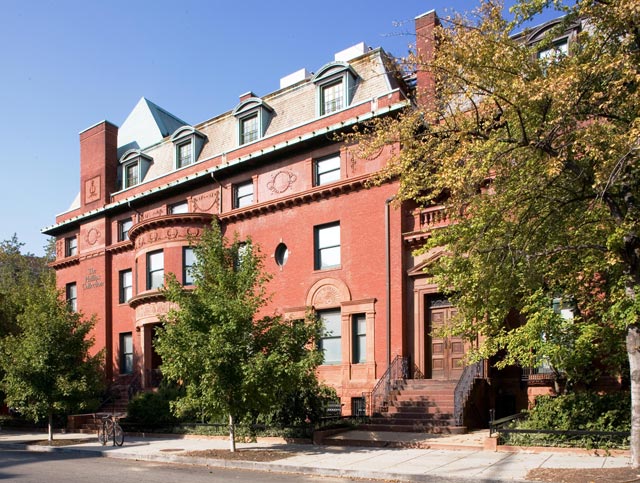I greeted the year 2013 with a new opportunity: the possibility to intern for Klaus Ottmann, Director of the Center for the Study of Modern Art and Curator at Large at The Phillips Collection. At our first in-person encounter, I could already feel impressed by his commanding yet discreet personality. He was a man of few words but, whenever he would decide to pronounce them, they would reflect both serious pondering and depth of content. My first connection with Klaus came through language. A native German-speaker himself, I was glad to be able to exchange some phrases with him and caught several glimpses of his smile at the comforting familiarity that comes with those words.
When I joined Klaus, he was working in the development of the exhibition Angels, Demons, and Savages – Pollock, Ossorio, Dubuffet. As a publication was meant to accompany the exhibition, Klaus invited me to join him in this endeavor through art historical research I could conduct both online and using The Phillips Collection’s on-site library. Klaus expressed his appreciation for my working skills in French and Spanish for I was readily able to find information that might bring him closer to the world Jean Dubuffet and Alfonso Ossorio, respectively. I therefore conducted multilingual translations (English, Spanish, French) to further support his research. It was a time of great learning for me, one that actually helped me to better savor other art historical research opportunities I would encounter in the future.
Thanks to Klaus, I also had my first taste of life in an exhibition room. We would visit this space several times throughout the day, bringing forward reflections on concepts that were still new to me, such as lighting, wall colors, wall text emplacement, and artwork location. It seemed to me that Klaus simply carried a blueprint of the exhibition space in his mind, for he was able to swiftly make decisions that would have otherwise been cumbersome for a curator without his expertise. He also recognized my opinion. For instance, I recall him standing next to me in front of a wall and asking: “Which of these two Pantones do you prefer?” I made a decision and he opted for it, followed by a comment as to why my choice would favor the placement of the artworks that would be shown on that wall. At other instances of decision-making from him or other members of his team, he would simply ask me to express what was on my mind. I quickly learned how to formulate my thoughts into concise phrases and consequently began gaining a novel sense of self-assurance. I very much enjoyed what I was doing and felt grateful for Klaus’s guidance. He had generously opened his world of a curator to me.
The writing component was essential to Klaus’s curatorial practice. For this matter, he welcomed my eagerness to make a written contribution to the exhibition. Stemming from my archival research, several of my texts earned Klaus’s approval and made it to to the official audioguide of the exhibition. I also could not believe my eyes when Klaus decided that one of my texts would make it as one of the wall texts in the exhibition. It was a detailed description of one of the paintings by Alfonso Ossorio. At the compliment “you are a good writer”, coming from Klaus, I felt an even stronger motivation to continue nourishing both my efforts and curiosity in this skill. The love for writing never left me, actually. Still to date, Klaus’s words resonate as one of the most powerful statements that helped me to further develop professionally.
There is another anecdote that never left my mind. One cloudy afternoon, Klaus could not hide his excitement at the news of a special arrival to The Phillips Collection: that of Jackson Pollock’s Number 1, 1950 (Lavender Mist) directly from the National Gallery of Art (NGA) in Washington, DC. As soon as he placed the phone down, he enthusiastically invited me to accompany him outside. Together we witness the moment in which the van carrying this precious canvas stopped in front of The Phillips Collection. Two men came out of the vehicle and opened the back door to reveal the largeness of the package. They carried it inside the museum and into the exhibition room. Once there, they meticulously unwrapped the artwork to Klaus’s delight. He was quite in awe and so was I, feeling that this moment would never leave me. The entire canvas was revealed to our gasping souls. Jackson Pollock’s Lavender Mist, a 221 x 299.7 cm (87 x 118 in.) was there before our eyes and commanded so much respect. It was a piece of art history. Also, quite the feat for Klaus for I would later learn that the NGA seldom granted its loan approval for this painting. Few people know that there is a dead fly underneath the myriad layers of painting. Seeing it there was like looking at a piece of time that had frozen. Pollock had certainly not meant to include this element in his work, however, as he had painted barefoot with the canvas on the floor of this studio, the natural elements of that day were welcome without restriction. A curious fly, indeed.
Like everything else in life, my internship, too, came to an end. If only there had been an opening in museum’s curatorial department I would have applied without hesitation. Instead, before the official end date of my contract with The Phillips Collection, I was offered a position as Assistant to the Cultural Attaché and Communications Officer at the Embassy of France in Washington, DC. I took this new responsibility convinced that my professional path was cultural diplomacy. I would consecrate several years to this exciting field. The taste for art, however, would always accompany me. Until one day it became clear that I should move to Italy to renew my ties with art history.
